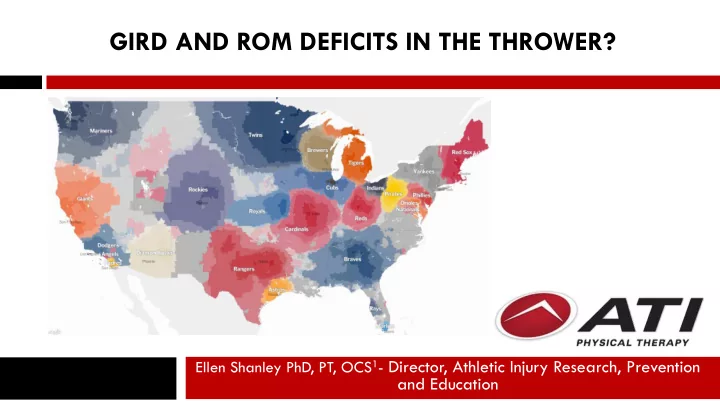

GIRD AND ROM DEFICITS IN THE THROWER? N Ellen Shanley PhD, PT, OCS 1 - Director, Athletic Injury Research, Prevention and Education
In order to throw a baseball… Generate Forces Dissipate Transfer Forces Forces Perfect Timing
Stresses of baseball cause adaptations Stresses > to deform & Strike a balance between injury change soft tissue & bone * & performance (Sabick AJSM ’ 05) Elite throwers need tissue to adapt for max performance (Meister AJSM ’ 05; Lesniak AJSM ‘13) Common adaptation- Shift in the arc of ROM
In order to perform at the highest level… Stability Controlled Mobility Skill mobility Manage Force Large ROM Repeated over time
So…
What is GIRD? Historically, a side-to-side difference IR Ξ GIRD 20° GIRD - clinical concern Case-Control studies Scapula stabilized
How & why- understanding evolved?…. HISTORICALLY PERSPECTIVE Burkhart 2000 Tyler 2000* Myers 2006* Ruotolo 2006 Dines 2009
Evidence: GIRD Retrospective Prospective • Yes • Maybe • 14-29 ○ • 20 ○
How does the evidence impact thoughts? Can the measure stand on its own ? Probably not
Evidence: S-S TARC Wilk ‘11 • Shanley ’ 11 • Wilk ’ 14 • Wilk ‘15 • Case-Control Prospective • Maybe • Maybe • 7-10 ○ • 5 ○ Ruotolo ‘06 • Garrison ‘12 • Myers ’ 06 • Dines ‘09 • Kibler ‘13 •
So then if its more complicated than IR? How much? Symmetric Sufficient Where? Intra vs extra-articular Isolated versus composite Quantity vs Control
Therefore, To assist clinicians S-S motion must reflect a deficit & not just a shift in motion The definition we use: Concurrent deficits - IR difference 15° + total arc of motion 10° or > Based on: Myers AJSM 2006, Wilk et al. AJSM 2011, Kibler et al Arthroscopy 2013
GIRD an Adaptation? Acceptable Healthy Transient- level of GIRD Overhead healthy Athletes pitchers (Burkhart ‘03) ( Ellenbecker ‘02, Meister (Reinold ‘08; Tokish ’ 08, ‘05, Hurd 11, Tokish Shanley ‘12) ’ 08,Wilk ‘12)
GIRD reflect specific tissue? HT, PI PI Capsule HT ROM △ ⇢ capsule, & thickening, associated- stretching/ GIRD ≠ posterior Loss of IR w soft tissue tightness plication TARC (Osbahr (Reinold ’ 08, (Tuite ’ 07; ’ 02; Shanley ’ 12; Laudner ’ 08; Moore (Burkhart ‘03) Thomas‘11; Gates Noonan ‘15) ’ 11; Bailey ’ 15; ‘12) Escamilla ’ 16)
Preventing Adaptation from becoming Pathology? Good genes Balanced loading, exposure & recovery Resiliency
In Summary then is GIRD…? An Impairment Pathological YES NO PROBABLY PROBABLY NOT A Symptom Causative A Risk Factor
Summary of the additional ROM evidence Longitudinal or progressive motion loss is concerning ER, Horizontal Adduction, & flexion deficits- (Wilk ‘15) Injury risk may not be related to just to IR or TARC difference GIRD lives in Healthy Pitchers too & may be transient (Tokish ’ 08) Pitchers with GIRD differences HT (Noonan ‘15)
Purpose? Originally a retrospective observation of overhead athletes presenting with pathology (Burkhart/Morgan ’ 00) Define and id a risk factor for injury
How & when should we consider ROM? Risk Profiling Returning to Sport Treatment Screening ITP RTS Testing Prevention
Similarities & Differences Youth Pros Adolescent
If ROM differences are risk factors… Screen a population @ risk of injury Customized prevention program Treatments (stretching & mobilization) are: Easy & inexpensive Minimal side effects Highly effective Cut off value-set low to include all of those @ high risk for injury
If ROM is a impairment/risk factor… Assessment is critical Apply algorithm to identify tissue contribution Id hypomobility Id implications of the deficit in motion Specify Treatment
Summary GIRD - asymptomatic S-S difference in IR not necessarily bad Assess shoulder motion (S-S) longitudinally Rotational deficits with a reduction in total arc may increase risk of injury Cardinal plane deficits flexion & horizontal adduction may increase arm injury risk Risk factors may be group specific Torsion is important in understanding shoulder motion present. Screening is the starting point!
Continued understanding of risk factors in throwers
Recommend
More recommend